 "Rusty Vandura - www.tinyurl.com/keepoppo" (rustyvandura)
"Rusty Vandura - www.tinyurl.com/keepoppo" (rustyvandura)
10/15/2018 at 10:54 • Filed to: None
 0
0
 36
36
 "Rusty Vandura - www.tinyurl.com/keepoppo" (rustyvandura)
"Rusty Vandura - www.tinyurl.com/keepoppo" (rustyvandura)
10/15/2018 at 10:54 • Filed to: None |  0 0
|  36 36 |
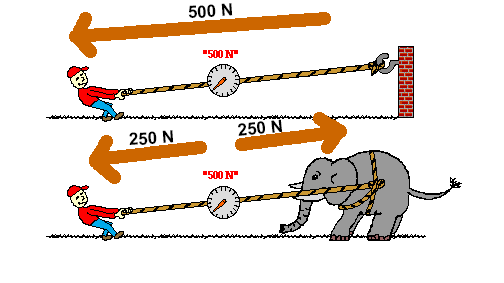
Does Little Dude have to work twice as hard in the first picture?
If I had a pair of frictionless pulleys and I hung 250 N on each end of a rope, there’s be 500 N of weight...
 Sir Halffast
> Rusty Vandura - www.tinyurl.com/keepoppo
Sir Halffast
> Rusty Vandura - www.tinyurl.com/keepoppo
10/15/2018 at 10:58 |
|
I’m not a physician, but that doesn’t look right.
 Future next gen S2000 owner
> Rusty Vandura - www.tinyurl.com/keepoppo
Future next gen S2000 owner
> Rusty Vandura - www.tinyurl.com/keepoppo
10/15/2018 at 11:00 |
|
That’s 250 N in the 2nd pic for the scale . Imagine if the elephant was replaced by a wall and the person was pulling with 250 N. The result on the dial would say 250 N.
 RamblinRover Luxury-Yacht
> Rusty Vandura - www.tinyurl.com/keepoppo
RamblinRover Luxury-Yacht
> Rusty Vandura - www.tinyurl.com/keepoppo
10/15/2018 at 11:00 |
|
If little dude isn’t moving, there is no simple Newtonian work being done at all.
/overly pedantic, not-entirely-serious
answer.
 Highlander-Datsuns are Forever
> Rusty Vandura - www.tinyurl.com/keepoppo
Highlander-Datsuns are Forever
> Rusty Vandura - www.tinyurl.com/keepoppo
10/15/2018 at 11:02 |
|
Edit: First pic he’s pulling 500 N. Second pic he is pulling 250 N and the gauge is reading wrong.
Issac Newton: A force is a push or a pull that acts upon an object as a results of its interaction with another object. ... These two forces are called action and reaction forces and are the subject of Newton’s third law of motion. Formally stated, Newton’s third law is: For every action , there is an equal and opposite reaction .
 RamblinRover Luxury-Yacht
> Rusty Vandura - www.tinyurl.com/keepoppo
RamblinRover Luxury-Yacht
> Rusty Vandura - www.tinyurl.com/keepoppo
10/15/2018 at 11:03 |
|
More serious answer: the first image has a couple of 500N vectors. The wall and Little Dude. The second image has a couple of 250N vectors. The stress in the rope is twice as high in the first image. The indication on the gauge in the second image is incorrect.
 ttyymmnn
> Rusty Vandura - www.tinyurl.com/keepoppo
ttyymmnn
> Rusty Vandura - www.tinyurl.com/keepoppo
10/15/2018 at 11:04 |
|
I prefer Fig Newtons.
 MasterMario - Keeper of the V8s
> Rusty Vandura - www.tinyurl.com/keepoppo
MasterMario - Keeper of the V8s
> Rusty Vandura - www.tinyurl.com/keepoppo
10/15/2018 at 11:06 |
|
If the gauge reads 500N then the person is pulling with 500N of force in both pictures...think of it this way, the wall is pulling wit h the same direction and force as the elephant.
 HFV has no HFV. But somehow has 2 motorcycles
> MasterMario - Keeper of the V8s
HFV has no HFV. But somehow has 2 motorcycles
> MasterMario - Keeper of the V8s
10/15/2018 at 11:10 |
|
that make total sense. Even if the person is just acting as an anchor they’d have to pull b y that much in order for the gauge it read it. If he wasn’t pulling back there wouldnt be as much resistance and he would just move.
 Aremmes
> Rusty Vandura - www.tinyurl.com/keepoppo
Aremmes
> Rusty Vandura - www.tinyurl.com/keepoppo
10/15/2018 at 11:11 |
|
Remember: every force has an equal and opposite force.
In the first picture, the 500 N exerted by the little guy are matched by 500 N on the wall hook to which the rope is fastened. In the second picture, he’s only exerting 250 N, opposed by 250 N from the elephant.
The gauges
are
meaningless here, and very much wrong
. The pictures imply some sort of pulley system like a block and tackle, or a spring
, which should make the gauge in the first picture read 1
000 N.
 LongbowMkII
> Rusty Vandura - www.tinyurl.com/keepoppo
LongbowMkII
> Rusty Vandura - www.tinyurl.com/keepoppo
10/15/2018 at 11:14 |
|
Is the rope ineleastic (like most simple physics problems) or not? If it’s elastic he only has to impart half the energy that is stored in the rope (Hooke’s law iirc, it’s been a while since 200 level physics)
 HammerheadFistpunch
> MasterMario - Keeper of the V8s
HammerheadFistpunch
> MasterMario - Keeper of the V8s
10/15/2018 at 11:16 |
|
Yup.
 CobraJoe
> Rusty Vandura - www.tinyurl.com/keepoppo
CobraJoe
> Rusty Vandura - www.tinyurl.com/keepoppo
10/15/2018 at 11:17 |
|
No, the tension in the rope (the reading on the scale) should be equal to the vectors on both sides.
In other words, the brick wall would have to be pulling just as hard as the elephant. If the elephant wasn’t moving, it wouldn’t be any different to a brick wall. (Resistance to motion is equivalent to a force in physics).
If I had a pair of frictionless pulleys and I hung 250 N on each end of a rope, there’s be 500 N of weight...
But there would only be 250N of tension in the rope between the two weights.
The rope would only need 250N to hold up the weight on each side below the pulley, and
tension in
rope cannot vary along it’s length (unless an additional force like friction or weight of the rope
is considered
).
The pullies, on the other hand, would together
need to support the full 500N of weight plus the 250N of tension in the rope. So, each pulley would see a 250N vertical force and a 250N horizontal force if the rope between the pullies is perfectly
horizontal.
 Dr. Zoidberg - RIP Oppo
> Rusty Vandura - www.tinyurl.com/keepoppo
Dr. Zoidberg - RIP Oppo
> Rusty Vandura - www.tinyurl.com/keepoppo
10/15/2018 at 11:17 |
|
I definitely don’t recommend getting into a tug-o-war match with an elephant
 HFV has no HFV. But somehow has 2 motorcycles
> HammerheadFistpunch
HFV has no HFV. But somehow has 2 motorcycles
> HammerheadFistpunch
10/15/2018 at 11:20 |
|
Im sorry th at I am so terrible at typing.
 OPPOsaurus WRX
> Rusty Vandura - www.tinyurl.com/keepoppo
OPPOsaurus WRX
> Rusty Vandura - www.tinyurl.com/keepoppo
10/15/2018 at 11:20 |
|
i think it the first part is correct than the wall would be moving to the left. the sum of the vectors would show where things are going. the second image, the scale would be stationary.. i think.
 LongbowMkII
> RamblinRover Luxury-Yacht
LongbowMkII
> RamblinRover Luxury-Yacht
10/15/2018 at 11:47 |
|
Or maybe he’s just dragging the wall
 RamblinRover Luxury-Yacht
> LongbowMkII
RamblinRover Luxury-Yacht
> LongbowMkII
10/15/2018 at 12:07 |
|
Hey, there’s still a 500N other side to that force couple whether he’s dragging it or not.
 LongbowMkII
> RamblinRover Luxury-Yacht
LongbowMkII
> RamblinRover Luxury-Yacht
10/15/2018 at 12:27 |
|
If it’s a frictionless surface there’s just the one force vector and the wall will accelerate to the left. Now if it’s in the real world that 500N will be somewhat or totally countered by the friction of the wall on the surface.
 RamblinRover Luxury-Yacht
> LongbowMkII
RamblinRover Luxury-Yacht
> LongbowMkII
10/15/2018 at 12:37 |
|
If it’s a frictionless surface, there’s still a couple. It just means the wall is
accelerating at a=F/m, and the process of acceleration is, from the force’s point of view, resistive to the right.
 LongbowMkII
> RamblinRover Luxury-Yacht
LongbowMkII
> RamblinRover Luxury-Yacht
10/15/2018 at 13:56 |
|
There’s N ormal, but that’d make no impact in the horizontal forces. Then again you’d need the angle to do the trig to find out how much of the 500N is vertical and horizontal.
We’re going to have the pedant police called on us.
 RamblinRover Luxury-Yacht
> LongbowMkII
RamblinRover Luxury-Yacht
> LongbowMkII
10/15/2018 at 14:16 |
|
Its physical
acceleration along x is definitely not 500N/(
u
kg)
as long as the force isn’t parallel, you’re right. It’d be (500N/(
u
kg)
) *cos(theta), with the couple for the normal forces being 500N*sin(theta) + 9.98*ukg
in magnitude. (Using “u” as the mass variable, assuming earth gravity
). You can still say it’s experiencing the whole 500N as acceleration in shorthand
, just like you can call gravity an acceleration even when it’s opposed. The sum acceleration vector is the sum of all acceleration vectors, after all - even though usually using forces makes more sense, and there aren’t many mass-proportional
forces
present other than gravity.
A
s long as the length of the rope and that geometry remains steady, it’
s one thing, but if he’s hauling in the rope,
that makes theta expressible as a function of x, and the acceleration function gets way more complicated.
 Rusty Vandura - www.tinyurl.com/keepoppo
> RamblinRover Luxury-Yacht
Rusty Vandura - www.tinyurl.com/keepoppo
> RamblinRover Luxury-Yacht
10/15/2018 at 15:48 |
|
That
much I kind of figured.
 Rusty Vandura - www.tinyurl.com/keepoppo
> CobraJoe
Rusty Vandura - www.tinyurl.com/keepoppo
> CobraJoe
10/15/2018 at 16:08 |
|
I think you see what I am getting at. Am I conflating force with mass? I never took Physics...
We assume no friction, et cetera.
Imagine two pulleys a meter apart, a rope slung between them, and a 250kg weight attached at each end, hanging, and the scale or meter suspended in the middle:
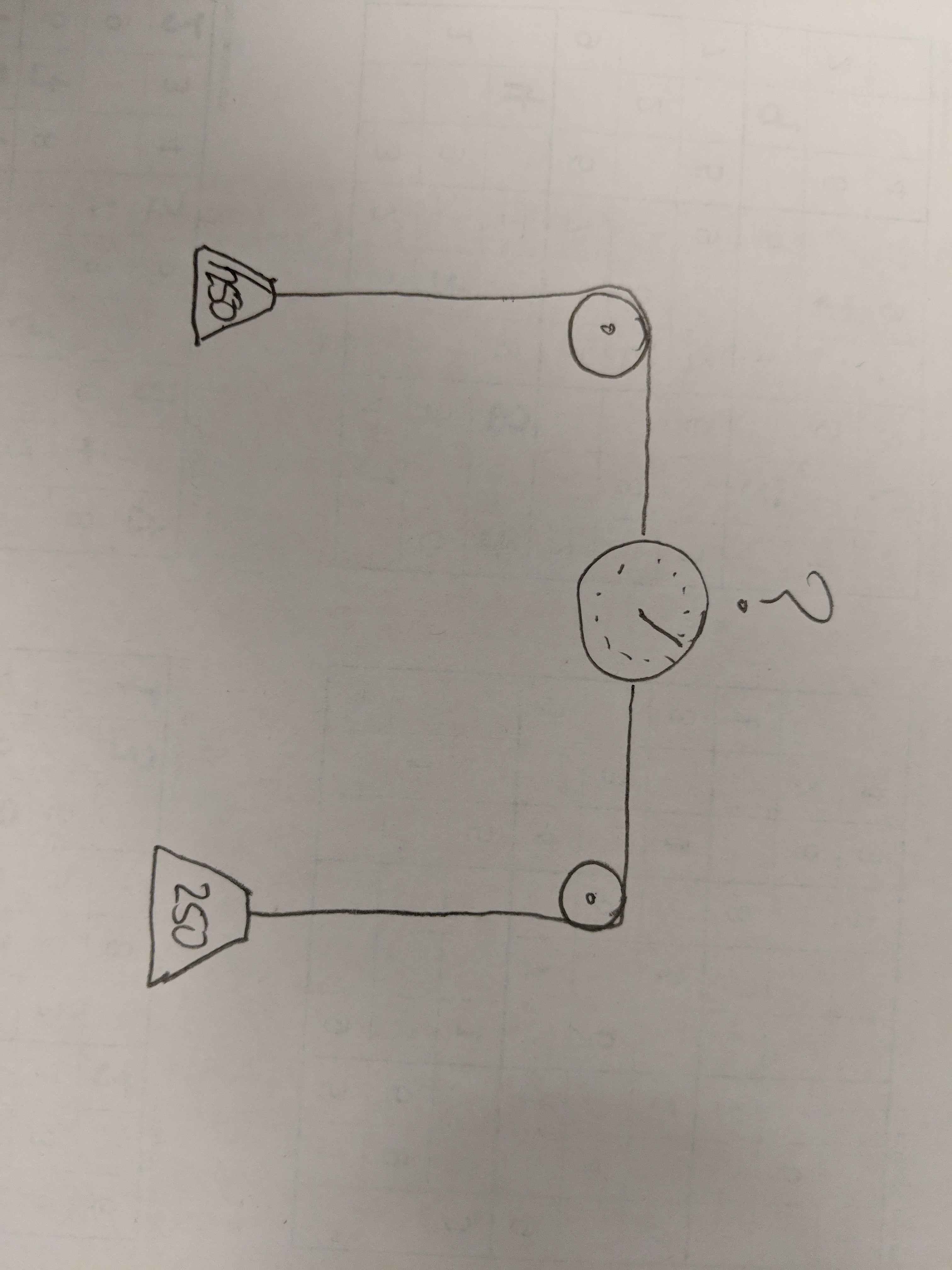
I don’t see how that system doesn’t weigh 500 kg, and nothing is moving anywhere, so no work is being done and each weight is applying 250kg of force.
What am I missing?
 CobraJoe
> Rusty Vandura - www.tinyurl.com/keepoppo
CobraJoe
> Rusty Vandura - www.tinyurl.com/keepoppo
10/15/2018 at 17:38 |
|
You are conflating force with mass a bit, but in this scenario, they’re equivalent. The force is created by gravity pulling on the masses attached to the rope. F=MA, and the acceleration of each mass is identical (only gravity), so the force each weight produces is proportional to it’s mass. Just don’t let a physics or engineering professor catch you making that assumption. (For the record, weight (lbs, or tons, or N) is a force, while kilograms is a mass.)
I don’t see how that system doesn’t weigh 500 kg, and nothing is moving anywhere, so no work is being done and each weight is applying 250kg of force.
What am I missing?
That system would weigh 500N total (excluding the rope and pulleys), but the force on the rope (the tension), is only 250N. (Sorry to switch units on you, it’s too weird for me to refer to kg as a force)
If you ignore one half of the diagram, you can see that the 250N weight must be balanced by a 250N horizontal force from the rope, while the pulley provides a force vector that will counteract both the horizontal and vertical forces.
The other half is a mirror image of that, with another vertical, horizontal, and diagonal component, except the horizontal force values will be in the opposite direction.
The trick is, the horizontal components of both sides are directly connected to each other, and because they are acting in exactly opposite directions, the net force is not added, it’s subtracted. The net force at the scale is zero, but that is caused by the 250N tension in the rope.
I feel like I didn’t explain it very well, but the simple explanation is that a rope can only support a single force, and the force is equal along the entire length of the rope (ignoring pulley
friction and rope weight of course)
.
 Rusty Vandura - www.tinyurl.com/keepoppo
> CobraJoe
Rusty Vandura - www.tinyurl.com/keepoppo
> CobraJoe
10/16/2018 at 11:41 |
|
I’ve been thinking about this and I think I understand it now. In the original image, Little Dude is applying 500N of force to the end of the rope, but doing no work. The wall, remaining stationary, is not exactly applying force , but is resisting Little Dude’s force at what has to be at least equal to what Little Dude is applying. So one might say that there is 500 N of tension on the rope and the scale is in the middle of the rope measuring that tension.
In my model — I’m the one who Photoshopped in the vectors — I halved the recipe. And when I hung two 250 kg weights on the scale, I had a total 500 N of force applied (as equal and opposite), but the load was shared between two lengths of rope — in my thinking — and was really only half of what was illustrated in the first picture because the scale was suspended between the halves of the piece of rope. And when I let both weights hang from the scale, yes, the scale would read 500 N, but what was the scale hanging from? A picture hook? Another piece of rope? The attachment point would be experiencing a 500 N load equal to the two weights on the two ropes hanging from the scale, and we’d be back to an incarnation of the original model.
My daughters say I overthink everything, BTW...
 Rusty Vandura - www.tinyurl.com/keepoppo
> RamblinRover Luxury-Yacht
Rusty Vandura - www.tinyurl.com/keepoppo
> RamblinRover Luxury-Yacht
10/16/2018 at 11:41 |
|
https://oppositelock.kinja.com/1829784190
 Rusty Vandura - www.tinyurl.com/keepoppo
> MasterMario - Keeper of the V8s
Rusty Vandura - www.tinyurl.com/keepoppo
> MasterMario - Keeper of the V8s
10/16/2018 at 11:41 |
|
https://oppositelock.kinja.com/1829784190
 MasterMario - Keeper of the V8s
> Rusty Vandura - www.tinyurl.com/keepoppo
MasterMario - Keeper of the V8s
> Rusty Vandura - www.tinyurl.com/keepoppo
10/16/2018 at 12:09 |
|
he wall, remaining stationary, is not exactly applying force , but is resisting Little Dude’s force at what has to be at least equal to what Little Dude is applying.
The wall is applying a force equal to the force the little dude is applying.
I think you’re getting confused by changing the system from a pulley problem to a tug of war one. The pullet itself is exerting 500N of force, but the rope only has 250N of force along it’s entire length which is what the dial would read...here’s a really bad sketch
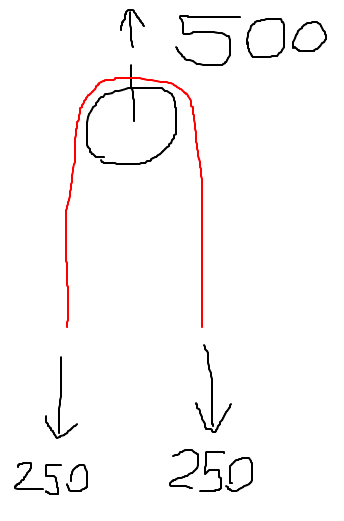
 RamblinRover Luxury-Yacht
> Rusty Vandura - www.tinyurl.com/keepoppo
RamblinRover Luxury-Yacht
> Rusty Vandura - www.tinyurl.com/keepoppo
10/16/2018 at 12:33 |
|
The difference between “resisting force” and “applying force” in the first diagram is a wholly semantic one that Newton doesn’t care about. The only reason to designate one element as passive is to highlight that the process by which Little Dude is generating that force is imperfect - he can’t do it forever, because his muscles can’t act *once* to apply the force and set him in place. Like if he were a marble statue that the rope was tied to, which was pushed far enough to put it in tension and left.
If Little Dude is hanging on a rope from the ceiling and weighs 51 kilos, the 500N force will be exactly the same as far as the rope is concerned, and as far as the involvement of a stationary object (wall/ceiling) is concerned.
Stop thinking about a force acting in *a direction*. Start thinking about “couples”. A force couple, a force pulling one way, and a force pulling the other way.

Here is your first detail, corrected.
Something to keep in mind with regard to forces is that the bookkeeping sometimes brings in extra forces to make everything add up. This is usually counterintuitive - where do the extra forces even come from? The answer lies in how the energy parses out when things move. You could just as well ask where the extra force to support a 300lb man vs. a 150lb man on the same floor comes from. The idea of “resisting force” vs. “applying”
is a mental trap because it’s all relative.
In your pulley case, the pulley is “resisting force” in your nomenclature for each weight and for the force of the rope pulling it toward the middle.

At each pulley there is a 250N force downward paired with a 250N force pulling it up, as well as a 250N force pulling left and the pulley’s moorings “resisting” for 250N right.
Ask yourself this - what is the tension in the cable on the right if the diagram looks like this?
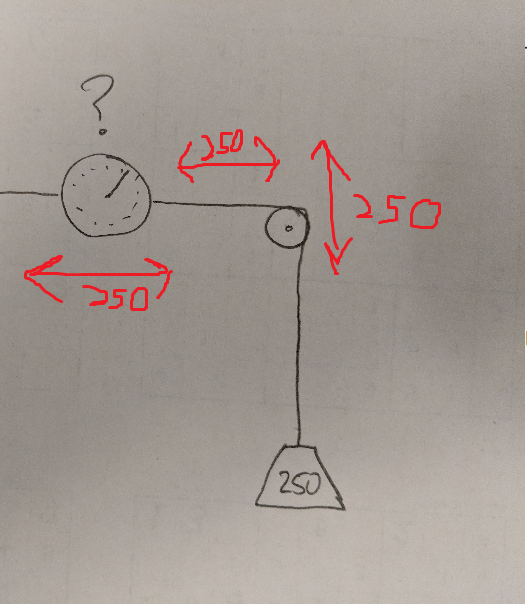
250N, as it always has been, except that the cable is moored to something on the left “resisting” for 250N worth instead of the weight “pulling” for 250N worth. It’s all the same.
Where the “extra weight” is being borne is at the pulleys , because there are two pulleys that have to “resist”, providing 250N upward each . The line, however, really doesn’t care. Its tension to support 250N is its tension, unless something happens to change the math.
Like this:
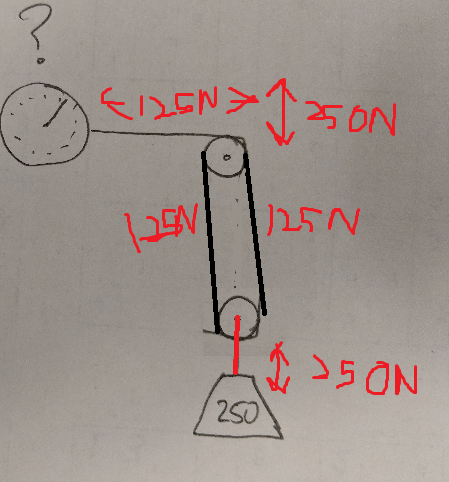
In this diagram, we’re looping around two pulleys. As you can see, the reaction in the vertical direction for the top pulley is the same, and the reaction below the lower pulley is the same, but because the line is now in tension on either side of the pulleys, it only has to be half as much. 2x 125N couples in the up/down dimension = 1x250N couple.
The reason that you can counterintuitively support the same weight with half the pull is the same reason levers work - there’s no spent energy until things move, and when things move, half the effort has to travel twice as far. Work is force times distance. No distance, no simple Newtonian work - only waste if any (see: human body, elephant).
This brings us back to why the couple between Little Guy and the elephant *isn’t* additive anywhere at all - because the two forces are not in the same direction, they’re opposed. When you think about the two weights together weighing 500N, they’re both pulling *down*. Therefore, the pulleys and their *moorings* have to (literally) take up the slack. Ask yourself this: what is the tension in a rope supporting a 500N-weight anvil beneath a hot air balloon? You’d better realize that it’s 500N, and not 1000N, even though the hot air balloon is pulling up with 500N. They’re not each pulling with 250N adding up to 500N.
You have got to understand that your intuition is wrong. Wrong, wrong, wrong. Balance of forces requires that you learn a new intuition - think of everything being suspended in weightless space by strings or springs
pulling in different directions in three dimensions
. Wherever the strings equalize... there you are.
 CobraJoe
> Rusty Vandura - www.tinyurl.com/keepoppo
CobraJoe
> Rusty Vandura - www.tinyurl.com/keepoppo
10/16/2018 at 13:21 |
|
I’ve been thinking about this and I think I understand it now. In the original image, Little Dude is applying 500N of
force
to the end of the rope, but doing no work. The wall, remaining stationary, is not exactly
applying force
,
but is resisting Little Dude’s force at what has to be at least equal
to what Little Dude is applying. So one might say that there is 500 N of
tension on the rope and the scale is in the middle of the rope
measuring that tension.
If it’s easier to think this way about it, the wall is effectively applying force by resisting motion. Just like how the elephant could resist moving by pulling back on the rope.
 Rusty Vandura - www.tinyurl.com/keepoppo
> MasterMario - Keeper of the V8s
Rusty Vandura - www.tinyurl.com/keepoppo
> MasterMario - Keeper of the V8s
10/16/2018 at 15:59 |
|
I think I understand the gist of it, but I have trouble with the semantics of that stationary, inert, static wall applying anything. To my thinking, what the wall is doing actively is resisting what Little Dude is applying.
For the sake of my edification, I am returning my thinking to the original drawing(s) and wrapping my head around it. Scratch the pulleys, for now...
My local hardware store went out of business because their massless, unstretchable
rope and frictionless pulleys were prohibitively expensive.
 Rusty Vandura - www.tinyurl.com/keepoppo
> RamblinRover Luxury-Yacht
Rusty Vandura - www.tinyurl.com/keepoppo
> RamblinRover Luxury-Yacht
10/16/2018 at 16:02 |
|
Lunch is short; I’ll have to read this later. Thank you for the effort.
 Rusty Vandura - www.tinyurl.com/keepoppo
> CobraJoe
Rusty Vandura - www.tinyurl.com/keepoppo
> CobraJoe
10/16/2018 at 16:05 |
|
It’s all in the accounting methods. I never took Physics and I think I would enjoy it now. Thanks for all the effort to help me make sense of it.
 MasterMario - Keeper of the V8s
> Rusty Vandura - www.tinyurl.com/keepoppo
MasterMario - Keeper of the V8s
> Rusty Vandura - www.tinyurl.com/keepoppo
10/16/2018 at 16:33 |
|
Resistance is force . If you push or pull something (a wall in this case) and it does not move that object is applying the same amount of force onto you to keep you stationary. If the forces do not balance you get motion...so if you pull a rope attached to an object with more force than the obj ect can exert, it will move
 CobraJoe
> Rusty Vandura - www.tinyurl.com/keepoppo
CobraJoe
> Rusty Vandura - www.tinyurl.com/keepoppo
10/16/2018 at 16:37 |
|
No problem, I rarely deal with these kind of problems anymore, so it’s fun to flex the mental muscles.
 Rusty Vandura - www.tinyurl.com/keepoppo
> MasterMario - Keeper of the V8s
Rusty Vandura - www.tinyurl.com/keepoppo
> MasterMario - Keeper of the V8s
10/16/2018 at 21:48 |
|
Bah! It’s an accounting trick!
...more force than the object can exert...
Thinking of it in those terms, if Little Dude pulls harder and the wall begins moving, then pulls less hard and the wall moves more slowly or stops, then there was acceleration and deceleration and if he pulled harder at varying degrees of
harderness
, then there’d be
jerk
and motion and it’s easier for me to wrap my head around. In this case, everything is static, but set up in such a way as to allow for, and account for,
the movement. But I understand how you physicists work: you make everything confusing enough for people of only average intelligence, or even above-average intelligence, then you can keep the rest of us guessing.